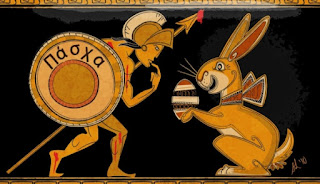Over the years I’ve written about the traditions of Greek Easter many times. This year I decided to let someone else describe those celebrations. I found that explanation on the Facebook page of the oldest Greek Bakery in Queens--located in the NYC heart of America’s best-known Greek neighborhood, Astoria. Here’s what the Victory Sweet Shop has to say:
For Greeks worldwide, Easter (April 16th) is the biggest religious holiday of the year.
HOLY WEEK is the week just before Easter that extends from Palm Sunday until Holy Saturday and marks the last week of Lent. It is full of symbolic events, festivities, and traditions followed by Greeks all over the world.
On THURSDAY, Greek Easter bread called Tsoureki is baked and the traditional red Easter eggs are dyed. This sweet bread is usually braided with three pieces of dough, which represent the Holy Trinity. The tsoureki symbolizes the Resurrection of Christ and rebirth as the flour is molded into shape and rises and takes on life as it transforms into its final shape. The red-dyed egg which is placed on top of the braid symbolizes the blood of Jesus. Nowadays, most people can easily buy the Easter Tsoureki at a Greek bakery.
On GOOD FRIDAY you’ll hear the church bells ring for the funeral of Christ. After the church service, the symbolic body of Christ, fashioned out of bundled sheets, is taken down from a cross and placed in a makeshift tomb called the Epitaphios, which is draped with an ornate tapestry and adorned with many flowers. The Epitaphios is then carried outside the church and paraded through the neighborhood before returning to the church for a closing ceremony.
SATURDAY is the last day of lent and it is filled with preparations for the midnight meal, including a traditional lamb offal soup called “Magiritsa” and a red egg cracking tradition called “Tsougrisma”. Just before midnight on Saturday everyone gathers at church with their Easter candles (Lambathes). The liturgy on Holy Saturday night is a truly unique experience. The churches are usually packed, and you will often see people spilling onto the church’s streets with white candles, which will be lit later with the Holy Light brought all the way from Jerusalem.
The Resurrection of Christ is celebrated at midnight sharp; the priest proclaims “Christos Anesti” (Christ has risen) with bells ringing and fireworks lighting up the sky outside. People greet each other with a “Christos Anesti” (Christ is Risen) and its reply “Alithos Anesti” (He has truly risen), lighting their candles along the way. Each person carefully carries their lit candle home in order to bless their home by drawing a cross with the flame on the doorway. Afterwards, they enjoy the Magiritsa soup and play the Tsougrisma tradition.
On EASTER SUNDAY, family and friends gather for a big Easter meal, which typically includes lambs roasting on a spit, loads of mezedakia, Greek salads, music & dancing. The Easter meal is truly special and a feast of joy and happiness.
Kali Anastasi!!! Καλή Ανάσταση!!!
Happy Easter!!! Καλό Πάσχα!!!
Thank you, Victory Sweet Shop
––Jeff

























A warm holiday efharisto from a once curious, yet now educated person
ReplyDeletePosted by another Jeff S.
DeleteShoer enough, Jeff S.:)
DeleteHow wonderful. Sounds like a great place to spend a second Easter, Jeff!
ReplyDeleteAnd fattening. :)
DeleteIn formerly-Greek Sicily, the Roman calendar is used, but the sweet bread with eggs baked in (not red) is still the traditional Easter treat. My Siracusan grandmother made ones to resemble a baby wrapped in a blanket for the girlsand dough shaped into a basket with an egg in it for the boys. I have always wished I had her recipe. Buona Pasqua from AA
ReplyDeleteSame face, same race, same Sis. Kalo Pasxa. :)
DeleteIt remains my favorite week to be in Greece.
ReplyDeleteMine too!
DeleteThis sounds lovely!
ReplyDelete